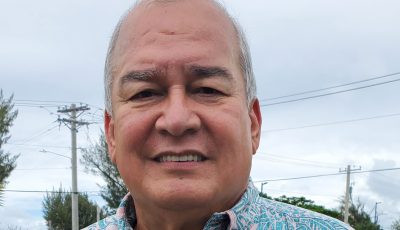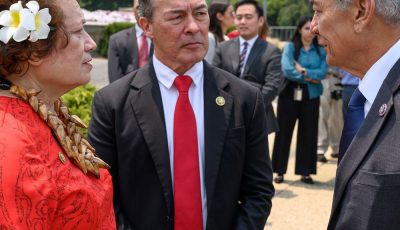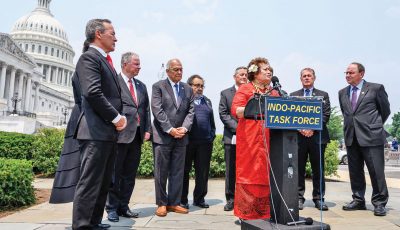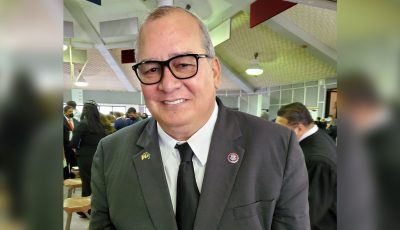Kilili, Babauta, Perez support 5-year review of planned Marianas National Marine Sanctuary
Delegate Gregorio Kilili C. Sablan (Ind-MP), Rep. Sheila J. Babauta (D-Saipan) and 500 Sails Inc. founder Emma Perez have expressed support for the five-year review of the proposed National Marine Sanctuary in the Mariana Islands.
In a joint comment submitted Monday to Kristina Kekuewa, the Pacific Islands regional director for National Oceanic and Atmospheric Administration Office of National Marine Sanctuaries, Sablan, Babauta, and Perez said they have reviewed the nomination and believe that the region continues to meet the criteria as a potential sanctuary.
“We ask that the proposed national marine sanctuary remain in the inventory,” they said.
The Office of National Marine Sanctuaries of the NOAA has requested written comments to facilitate ONMS’ five-year review of the nomination for the Mariana Trench National Marine Sanctuary at the five-year interval.
Following this information gathering and internal analysis, NOAA will make a final determination whether or not the Marianas Trench NMS nomination will remain in the inventory for another five-year period. The deadline for public comments was Feb. 22, 2022.
In response to Saipan Tribune’s request for comments on the matter, Babauta, who chairs the House of Representatives Natural Resources Committee, said she supports science, research, and education.
Babauta said that keeping the Marianas on the inventory as a potential National Marine Sanctuary will provide additional resources needed for the CNMI to explore and study the waters around it, “so we can better protect and conserve our ocean and cultural practices for future generations.”
The lawmaker said so much “fake news” has been spreading about this step in the process and that it’s very harmful and quite scary.
“The fact is, right now NOAA is only asking whether or not we should keep it on the inventory. That’s it,” she said.
Babauta said if the CNMI is chosen for designation, that would be a completely different process and it would take several years because they are required by law to heavily involve the community and conduct outreach and education.
Babauta coordinated the Environmental Sustainability and Stewardship Stakeholders working group to address issues that impact the lands and waters of the CNMI.
Participants of the working group include the members of the House committee, Executive Branch offices, local and national non-government organizations, federal agencies, local businesses, scientists, and concerned citizens.
Sablan, Babauta, and Perez said that, as official representatives of their respective agencies and organizations, they look forward to beginning the community consultations to support the designation of the sanctuary, and commit to engaging and partnering with federal partners to support implementation, to best benefit the community.
They encouraged the Biden administration to prioritize moving the sanctuary forward toward designation.
Sablan, Babauta, and Perez said this indigenous-led sanctuary can play a critical role in the America the Beautiful Initiative, and will play a globally significant role in achieving designating and implementing 30% of the ocean in marine protected areas and other effective conservation measures.
The three support the three recommendations put forward by the Friends of the Mariana Trench, the original nominators of the national marine sanctuary.
First, they said, they support making no substantive changes to the CNMI’s nomination, but request to amend the proposed name.
“Our waters are home to the iconic Mariana Trench, the deepest trench in the world’s ocean. This is something to be proud of, and we want to include it and keep it in our nomination,” they said.
Sablan, Babauta, and Perez said they, however, would like to bring greater attention to the stewardship of the people who have called this place home for more than 4,000 years ago and that they suggest that the name reflect the CNMI’s heritage.
Second, the three stressed the importance of co-management for the proposed national marine sanctuary. They asked that during the designation process, the proper CNMI government agencies and/or indigenous representatives are included in both management, decision making, and advisory roles.
Finally, Sablan, Babauta, and Perez emphasized that they are not proposing any additional restrictions for small fishing vessels homeported in Guam, Saipan, Tinian, or Rota, nor do they think their proposal will affect any existing commercial offshore fisheries. They do, however, want to address foreign and illegal fishing with the sanctuary.
They preferred that the proposed borders of the sanctuary emerge with extensive community engagement during the process of designation.
In recent years, surveys, tagging and acoustic studies have documented that the Marianas region is a highway for migrating species, including humpback whales who summer in Russia and Alaska, whale sharks who traverse the Pacific rim from Central America, and sea turtles, who nest and spend their first decades around the islands before migrating across the globe.
Sablan, Babauta, and Perez said the highest diversity of coral specifies in U.S. waters occurs in the Marianas, and these resources serve as a multi-million-dollar attraction to overseas tourists who will be critical for economic recovery once the COVID-19 pandemic ends.



























